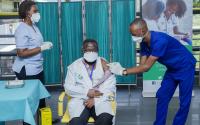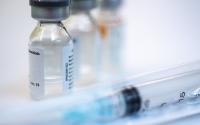[ad_1]
Table of Contents
Phase 1 and 2 trials show J&J COVID vaccine safe, immune-producing
Interim phase 1-2a results from Johnson & Johnson’s COVID-19 vaccine trials show that its vaccine, Ad26.COV2.S, produces a good immune response and safety profile, according to a New England Journal of Medicine study yesterday.
Unlike the two messenger-RNA vaccines currently in use in the United States, the Johnson & Johnson vaccine uses a recombinant, non-replicating adenovirus 26 (Ad26) with a complete and stabilized spike protein.
“A single dose of Ad26.COV2.S elicited a strong humoral response in a majority of vaccine recipients, with the presence of S-binding and neutralizing antibodies in more than 90% of participants, regardless of either age group or vaccine dose,” write the researchers.
The researchers gave one or two doses of a low- or high-dose vaccine or placebos to 402 people aged 18 to 55 and 403 people 65 and older. Almost 95% of the US and Belgian participants were white.
Mild to moderate adverse events included fever, fatigue, headache, myalgia, and injection-site pain. In the younger group, 15 (9.3%) low-dose recipients and 32 (20.3%) high-dose recipients reported severe systemic events, compared with 1 (0.6%) and 4 (0.2%) in the older group. One participant (0.1%) had a vaccine-related fever that required hospitalization, but it resolved within 12 hours.
The researchers found that, 29 days after vaccination, the neutralizing-antibody geometric mean titer (GMT) level in younger people was 224 (after one low dose) to 354 (after two high doses), with at least 99% seroconversion. In older recipients, day 29 results ranged from 277 (one low dose) to 212 (one high dose) GMT, with at least 96% seroconversion. Titers increased and remained stable through day 71 in the younger cohort, ending between 321 (one low dose) and 1,266 (two high doses). They were not measured beyond day 29 in the older cohort.
As studies continue, the researchers will assess the benefit of a second vaccine dose for the elderly. If the vaccine receives an emergency-use authorization from the Food and Drug Administration, Johnson & Johnson has a deal with the US Department of Health and Human Services for 100 million doses, although The New York Times reports that manufacturing is behind schedule.
Jan 13 N Engl J Med study
Men more vulnerable to COVID-19 complications, death, than women
Men are more likely to test positive for COVID-19, have complications, and die from their infections than females—regardless of age, according to a study published yesterday in PLOS One.
The study, led by researchers at Houston Methodist Research Institute in Texas, used electronic medical record data from a large healthcare provider to analyze the link between sex and COVID-19 in 14,992 adults from Mar 2 to Aug 22, 2020.
Among 96,473 adult patients tested for COVID-19, 14,992 (15.6%) had positive results; 4,785 (31.9%) of them were hospitalized, and 452 (9.5%) died. The positive testing rate was 15.5% among all patients and was higher in men than women (17.0% vs 14.6%; odds ratio [OR], 1.20). The sex difference was unchanged after adjustment for age, race, ethnicity, marital status, insurance type, median income, body mass index, smoking status, and 17 underlying illnesses included in the Charlson Comorbidity Index (adjusted OR, 1.39).
Men were also more likely than women to develop pulmonary complications such as acute respiratory distress syndrome and respiratory failure with low oxygen levels, and nonpulmonary complications such as acute kidney injury, during hospitalization. Women had lower rates of in-hospital death than men (8.3% vs 11.6%; OR, 1.44).
Men were significantly more likely to require intensive care than women (34.1% vs 27.6%; OR, 1.36). More men than women required mechanical ventilation (19.0% vs 14.7%; OR, 1.36). The men in the cohort were significantly older than the women (mean age, 53.3 vs 49.8 years) and predominantly white (66.7% vs 64.0%).
Underlying medical conditions such as high blood pressure, heart attack, congestive heart failure, peripheral vascular disease, cerebrovascular disease, diabetes, cancer, and HIV/AIDS were much more prevalent in men However, preexisting illnesses such as rheumatic disease, chronic pulmonary disease, mild cognitive impairment/dementia, and other neurological conditions, were more common in women.
“Sex disparities in COVID-19 vulnerability are present, and emphasize the importance of examining sex-disaggregated data to improve our understanding of the biological processes involved to potentially tailor treatment and risk stratify patients,” the authors wrote.
Jan 13 PLOS One study
College students report high levels of COVID-19 pandemic distress
Another study published in PLOS One finds that upwards of half of all US university students have experienced high levels of distress early in the COVID-19 pandemic.
A team headed by Clemson University researchers analyzed data from online questionnaires collected from 2,534 students at seven large state universities from mid-March to early May, 2020, when most were under stay-at-home orders.
The researchers noted that college students are known to be especially vulnerable psychologically, experiencing more depression, anxiety, substance abuse, and eating disorders than the rest of the US population. They are also, the authors said, among the most strongly affected by the pandemic because of worries about academic success, future work possibilities, and social life.
All respondents indicated being affected negatively by the coronavirus pandemic in some way, with 59% reporting high levels of psychological distress. Factors associated with higher levels of psychological impact were female sex, non-Hispanic Asian race, fair or poor health, below-average family income, knowing someone infected with COVID-19, and having more than 8 hours of screen time daily.
Conversely, factors linked to a lesser psychological impact included white race, higher socioeconomic status, and spending 2 or more hours outside daily. Of all respondents, 61% were women, 79% were white, and 20% were graduate students.
The authors suggest that college administrators find ways to support students’ mental health and academic success during the pandemic to avert long-term consequences. Such actions might include holding virtual group exercise and mindfulness sessions, exercise challenges, online social events, healthy mindset trainings, outreach to particularly at-risk groups, peer mentoring, remote office hours, and virtual counseling sessions and having “accountability buddies.”
The researchers said that students must have their basic physiological, psychological, and safety needs met before they can excel in college. “We recommend that university administrators take aggressive, proactive steps to support the mental health and educational success of their students at all times, but particularly during times of uncertainty and crisis,” they wrote.
Jan 7 PLOS One study
[ad_2]
Source link












